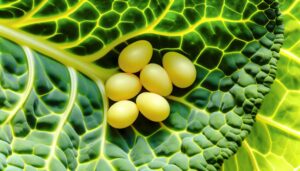How Do Cabbage White Butterflies Lay Their Eggs in Your Garden?
Cabbage white butterflies, scientifically known as Pieris rapae, lay their eggs primarily on plants within the Brassicaceae family, which includes cabbages, mustards, and broccoli. Female butterflies are attracted to the glucosinolates in these plants, as these compounds provide essential nutrients for the larvae.
Using chemoreceptors, females selectively deposit spindle-shaped, yellow eggs on the foliage. Adhesive secretions secure the eggs, minimizing predation risks.
This strategic placement not only guarantees ideal larval nutrition but also boosts survival rates. Hormonal regulation dictates the timing of this oviposition, which peaks in mid-summer.
A deeper exploration reveals the intricate seasonal and ecological impacts.

Key Takeaways
- Cabbage white butterflies lay their eggs on the foliage of Brassicaceae family plants.
- Female butterflies use chemoreceptors to select suitable host plants for egg-laying.
- Eggs are adhered securely to leaf surfaces via adhesive secretion.
- Strategic egg placement ensures easy nutritional access for emerging larvae.
Preferred Plants

Cabbage white butterflies (Pieris rapae) exhibit a strong preference for laying their eggs on plants within the Brassicaceae family, such as kale, broccoli, and cabbage, due to the presence of glucosinolates which provide essential nutrients for the developing larvae.
These glucosinolates, secondary metabolites present in Brassicaceae, play a vital role in the larvae's growth and survival by serving as chemical cues that attract female butterflies.
The larvae's ability to detoxify these compounds allows them to exploit these plants efficiently, while other herbivores may be deterred.
This selective oviposition strategy optimizes larval performance and increases survival rates, underscoring an evolutionary adaptation that aligns the reproductive success of Pieris rapae with the chemical ecology of their host plants.
Egg-Laying Process
Building upon their preference for Brassicaceae plants, female Pieris rapae butterflies exhibit a meticulous egg-laying process that involves several distinct behavioral and physiological stages.
Initially, the female engages in host plant selection, using chemoreceptors on her antennae and tarsi to detect suitable foliage. Upon locating a prime leaf, she positions her abdomen to deposit a single, yellow, spindle-shaped egg.
This process is governed by precise hormonal regulation, ensuring the eggs are laid during favorable conditions for larval development. The egg is affixed with an adhesive secretion, securing it to the leaf surface.
This strategic placement minimizes predation and maximizes nutritional availability for emerging larvae, thereby enhancing offspring survival rates.
Seasonal Patterns

Understanding the seasonal patterns of Pieris rapae egg-laying behavior is essential for comprehending their life cycle dynamics and population fluctuations. This butterfly species exhibits distinct seasonal variations, driven primarily by temperature and photoperiod.
During spring and summer, females actively lay eggs on host plants such as Brassica species, leveraging the ideal environmental conditions for larval development. Egg-laying peaks in mid-summer, corresponding with increased plant availability and favorable climatic conditions.
As temperatures decline in autumn, egg-laying activity diminishes, coinciding with a decrease in host plant abundance. The cessation of oviposition during winter underscores the species' adaptation to temperate climates, with diapause in the pupal stage ensuring survival until favorable conditions resume.
This cyclical pattern is pivotal for maintaining population stability.
Garden Impact
The presence of Pieris rapae eggs in gardens considerably influences plant health and yield, as the emerging larvae voraciously consume foliage, particularly of cruciferous crops. These larvae, known as cabbage worms, can cause extensive damage, leading to stunted growth and reduced crop quality. Gardeners and agriculturalists must be aware of the significant impact these pests can have.
Key consequences include:
- Defoliation: Complete stripping of leaves, impeding photosynthesis.
- Reduced Yield: Lower quantity and quality of harvestable produce.
- Increased Susceptibility: Plants become more vulnerable to diseases.
- Economic Losses: Substantial financial impact on commercial growers.
Understanding these impacts is vital for effective garden management and ensuring healthy crop production.
Prevention Tips

Implementing effective prevention strategies is essential to mitigate the detrimental effects of Pieris rapae larvae on cruciferous crops.
One recommended approach is the utilization of floating row covers, which physically block adult butterflies from accessing plants to lay eggs.
Additionally, intercropping with aromatic herbs like dill or cilantro can deter oviposition due to their strong scents.
Biological control using natural predators, such as parasitoid wasps (Cotesia glomerata), also proves effective in reducing larval populations.
Regular inspection of crops for eggs and larvae is vital, allowing for prompt manual removal.
Conclusion
The cabbage white butterfly exhibits a distinct preference for laying eggs on cruciferous plants, engaging in a meticulous egg-laying process that guarantees ideal conditions for larval development. The cabbage white butterfly eggs are typically deposited on the underside of leaves, where they are sheltered from predators and environmental extremes. This strategic placement ensures that once the larvae hatch, they have immediate access to a nutritious food source. As a result, the survival rate of the emerging caterpillars is significantly enhanced.
Seasonal patterns reveal heightened egg-laying activity during warmer months, directly impacting garden ecosystems.
Consequently, the presence of these butterflies necessitates vigilant monitoring and strategic prevention measures to mitigate potential damage to crops.
Understanding these behavioral patterns and implementing targeted interventions can greatly reduce the adverse effects of cabbage white butterflies on agricultural productivity.






